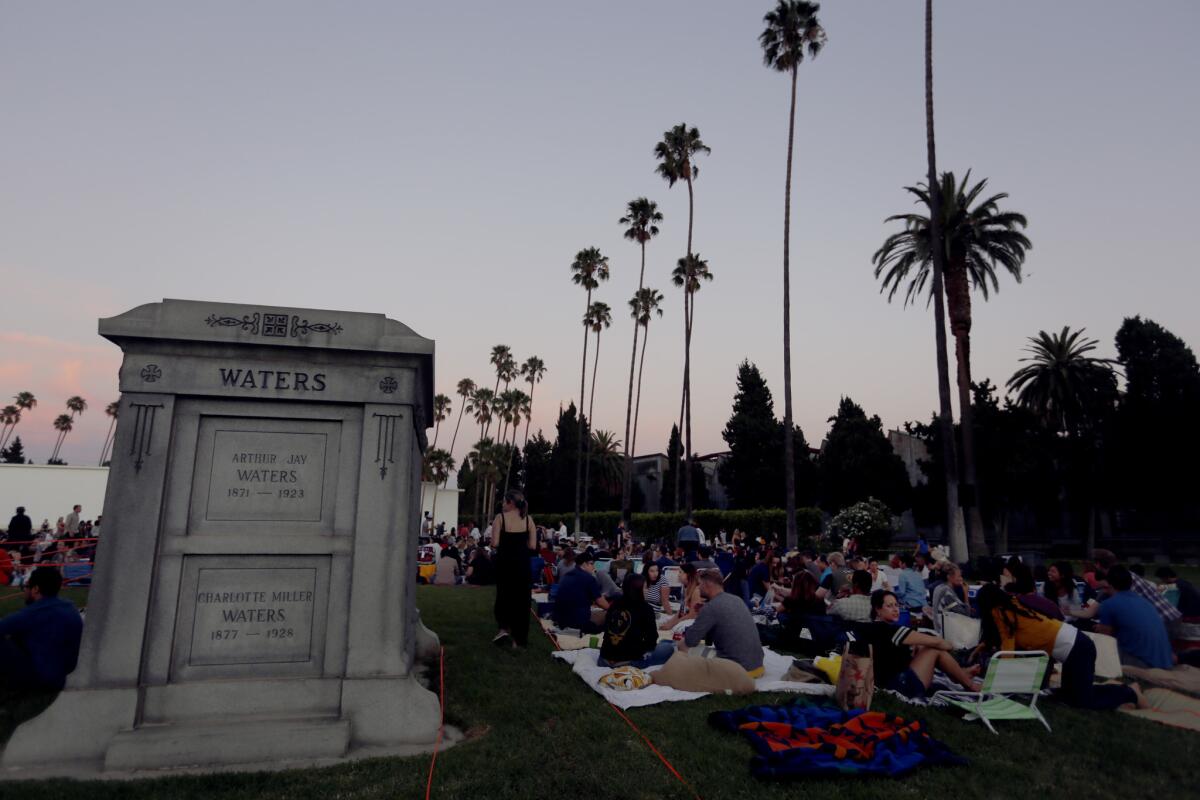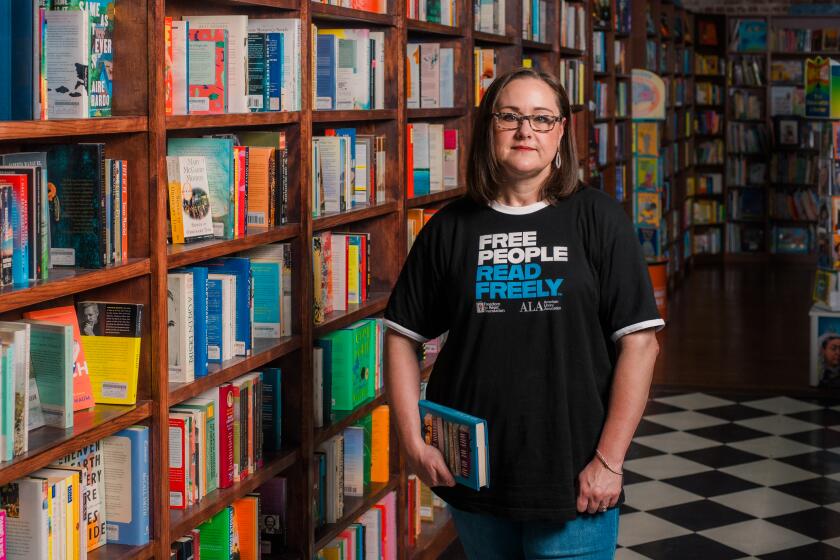Sex, death and cinema: Meet Navid Sinaki, the author behind L.A.’s cemetery movie nights

Navid Sinaki is the creative director of Cinespia at Hollywood Forever. He’s also an author. He opens up about growing up ‘quiet, queer and Persian.’
Good morning and thanks for reading the L.A. Times Book Club newsletter!
I’m novelist and punk historian Jim Ruland, and even though I love books, when the temperature rises, you can find me at the movies. The next best thing? A lurid summer read that oozes with sex, death and cinema.
Navid Sinaki’s debut novel, “Medusa of the Roses,” which will be published by Grove Press next week, checks all the boxes. It’s a taut story of doomed love set in Tehran and shot through with noirish imagist poetry.
When Anjir’s lover, Zal, disappears, he fears the worst, but his search uncovers complicated truths that put both their relationship and their lives in jeopardy. Anjir’s compulsion to steal from friends and enemies alike ups the ante, making “Medusa of the Roses” both hard-boiled and hard to put down.
I sat down with Sinaki, who is also an experimental filmmaker and the creative director at Cinespia at Hollywood Forever, to ask about his new book and growing up “quiet, queer and Persian.”

Can you tell me a bit about your background?
I was born in Tehran, but my parents moved to the U.S. because of one bombing too many during the Iran-Iraq War. My mom blames Saddam Hussein for destroying her collection of mirrors: the heirloom vanity, her father’s antiques with the Shah’s silhouette on the frames, even the Minnie Mouse mirror near my crib (perhaps my first gay icon).
Were you able to return to Tehran?
We would visit Iran often during the summers, trips I hated as an anxious suburban kid because I could only take a finite amount of books with me. Plus, their burgers tasted like kabob, so I had my prejudices. My final visit was when I was 21, a research excursion for my honors thesis on Persian films from before the Islamic Revolution — swinging B-films, sexploitation romps, and melodramas from the 1960s and ‘70s. The day prior to this visit, I had an amazing first date, despite the fortune teller who told me I would never find love as soon as she saw us together. So my last trip to Iran was a swirl of genre films and conjecture.
Did you feel at home during your visits there?
I had started making queer video art. Though it was a stretch to think the militaristic customs officials would look me up by name, I knew there were dangers to returning. Though homosexuality is criminalized in Iran (even punishable by death), the government helps subsidize sex reassignment surgery. This loophole was something that stuck out in my mind. In Rancho Cucamonga, I didn’t exactly feel safe as a queer kid discovering his sexuality in the aftermath of 9/11.
You’re reading Book Club
An exclusive look at what we’re reading, book club events and our latest author interviews.
You may occasionally receive promotional content from the Los Angeles Times.
How was conservative California different?
In the SoCal suburb where I grew up, where street banners laud the graduates who joined the armed forces, I was an awkward kid trying not to draw attention to being different — quiet, queer and Persian. The closest I got to a museum was the art section of Barnes & Noble. I learned about jazz from the local Mimi’s Cafe. My art house theater was Turner Classic Movies.
What writers were models for you?
9/11 was a cockblocker for a Persian queer kid coming of age in the suburbs. A certain animosity took place. Sex was sadomasochistic, and hookups were surreal. I learned about simultaneity from Jean Genet. I fell into his work because I understood in my own way that lust could be poetic and perverse, courtship could be camp and cruel, and struggling to stay alive was jocoserious. I thrived in his acid humor, with opulent language that twisted melancholy, at once rococo and blue.
What’s it like working as creative director for Cinespia at Hollywood Forever Cemetery?
Me and [silent film star Rudolph] Valentino go way back. I’ve spent countless summer nights near his mausoleum. At Cinespia, 4,000 people gather at the Hollywood Forever Cemetery to watch films projected on the side of a mausoleum. Douglas Fairbanks is nearby. Cecil B. DeMille is another onlooker. Judy Garland and Johnny Ramone are there too. Each screening has a photo booth lit with professional lighting and photographers to give people a chance for their own close-ups. I’m responsible for the dream work behind these booths, which I think of as art installations, rather than copycat scenes from movies.
How did your experience as a filmmaker influence the composition of the novel?
As a filmmaker, I’m always unlooking: queering folktales to imagine a space in them for me; using DVD menus as diaries, repurposing clips from ‘60s Persian sexploitation films to tell a trans love story in the form of a film trailer. Film allowed me to look at myself as a site for discovery, a wandering city. A screen can be an unlooking glass. I’ve learned to double down in my writing too. Maybe I’m like Narcissus falling into my own reflection. Instead of blooming into narcissus flowers after drowning, for me roses sprouted from that death.
The Week(s) in Books

Francine Pascal, creator of the “Sweet Valley High” books, and Irish novelist Edna O’Brien have died.
In his review of “Kent State: An American Tragedy” by Brian VanDeMark, Chris Vognar unpacks the book’s first sentence: “People don’t withhold the whole truth unless the whole truth is too much to bear.”
Vognar also reviews Brett Anthony Johnston’s “We Burn Daylight,” a novel that explores the human side of the tragedy that unfolded during the federal government’s standoff with David Koresh in Waco, Texas.
Leigh Haber reviews Helen Phillips’ new novel “Hum” and suggests it walks the line between dystopian fiction and a glimpse at our very near future.
(Please note: The Times may earn a commission through links to Bookshop.org, whose fees support independent bookstores.)
L.A. Writers Recommend

“Sex, death and cinema” isn’t a genre (yet), so I asked some of my favorite LA writers for their recommendations in this category. Here’s what they had to say:
Melissa Broder, author of “Death Valley,” suggests “Turkish Delight” by Dutch author Jan Wolkers. Originally published in 1969, a new translation by Sam Garrett was released in 2107 by Tin House.
Matthew Specktor knows a thing or two about cinema. The author of “Always Crashing in the Same Car: On Art, Crisis, and Los Angeles, California” recommends Charlie Kaufman’s “Antkind,” which he describes as “wild, challenging, and funny.”
Steve Erickson’s “Zeroville” gets Nolan Knight’s endorsement. The Long Beach author of “Gallows Dome” says, “If you’re a film geek, it’s heaven.”
LA Times Book Prize winner Steph Cha recommends “The Song Is You” by Megan Abbott and “Everybody Knows” by Jordan Harper.
Thanks for reading! I’ve enjoyed writing the LA Times Book Club newsletter this summer, and now I’ll pass the baton to another book lover!
Sign up for our Book Club newsletter
Get the latest news, events and more from the Los Angeles Times Book Club, and help us get L.A. reading and talking.
You may occasionally receive promotional content from the Los Angeles Times.



